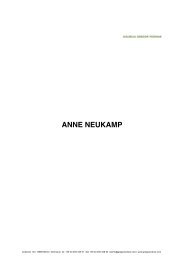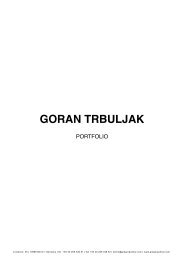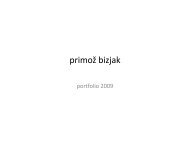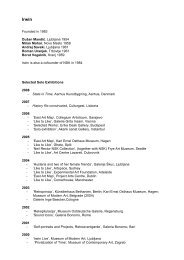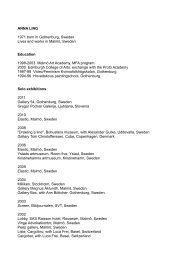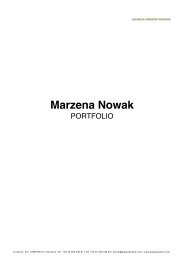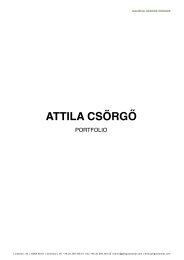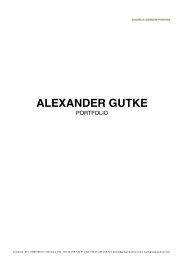Download file - Galerija Gregor Podnar.
Download file - Galerija Gregor Podnar.
Download file - Galerija Gregor Podnar.
Create successful ePaper yourself
Turn your PDF publications into a flip-book with our unique Google optimized e-Paper software.
ION GRIGORESCU<br />
PORTFOLIO<br />
Lindenstr. 35 | 10969 Berlin | Germany | tel. +49 30 259 346 51 | fax +49 30 259 346 52 | berlin@gregorpodnar.com | ww.gregorpodnar.com
Ion Grigorescu is one of the most significant Rumanian artists of the Post-War period. Since 1967,<br />
he has been working on issues of sexuality, body and politics from both a communistic and<br />
capitalist point of view, based on historical changes. By the end of the '70s Grigorescu began<br />
recording his performances, which concentrated on ritualized actions around his body. His<br />
performances go beyond art and lead into a private and personal life. His most recent works are<br />
avowals of daily life and show photos of his family and intimate moments, reflected his growing<br />
interest in spirituality, as inspired by orthodox religious tradition in Romania.
FILMS
Walk<br />
Super 8 film transferred into 16 mm film and digital format, duration: 3' 33'', ed. of 5 + 2 AP, 1974
Trap, Trap of Horseshoes<br />
Super 8 film transferred into 16 mm film and digital format, duration: 2ʼ 17ʼʼ, ed. of 5 + 2 AP, 1975
Ziua Martei<br />
Super 8 film transferred into 16 mm film and digital format, duration: 7' 17'', ed. of 5 + 2 AP, 1976
Male and Female<br />
Super 8 film transferred into 16 mm film and digital format, duration: 12' 50'', ed. of 5 + 2 AP, 1976
Beloved Bucharest<br />
Super 8 film transferred into 16 mm film and digital format, duration: 14' 37'', ed. of 5 + 2 AP, 1977
Town and Earthquake<br />
Super 8 film transferred into 16 mm film and digital format, (edited 2010), duration: 9ʼ 38ʼʼ, ed. of 5 + 2 AP, 1977
In Dialogue with Ceauşescu the artist plays two opposing roles, in one of which he is wearing a mask with the face<br />
of Ceauşescu.<br />
Dialogue with Ceauşescu<br />
Super 8 film transferred into 16 mm film and digital format, duration: 6'44'', ed. of 5 + 2 AP, 1978
Man at the Center of the Universe<br />
Super 8 film transferred into 16 mm film and digital format, duration: 5' 58'', ed. of 5 + 2 AP, 1978
Balta Alba<br />
Super 8 film transferred into 16 mm film and digital format, duration: 7' 55'', ed. of 5 + 2 AP, 1979
URSS<br />
Super 8 film transferred into 16 mm film and digital format, duration: 2' 13'', ed. of 5 + 2 AP, 1981
Study for Oedipus<br />
Super 8 film transferred into 16 mm film and digital format, (edited 2010), duration: 12ʼ 15ʼʼ, ed. of 5 + 2 AP,<br />
1982-85
Oedipus<br />
Digital video, duration: 8ʼ45ʼʼ, ed. of 5 + 2 AP, 1994
Scaffolding<br />
Digital video, duration: 14' 11'', ed. of 5 + 2 AP, 2010
Start<br />
Digital video, ed. of 5 + 2 AP, 2010
VINTAGE PHOTOGRAPHS<br />
& PRINTS
Cheese<br />
Silver print, 29,8 x 39,8 cm, 1975
Horses<br />
Color print, 24 x 29,8 cm, 1978
Mariuca Iosifescu II<br />
Vintage silver print, collage on plywood, 45 x 45 cm (unframed size), framed, 1973
Self Portrait<br />
Silver print, 29,3 x 40 cm, unique, 1974
Jump From the Tree<br />
Silver print, 60 x 50 cm, framed, unique, 1978
Trăisteni, detail (the Serf)<br />
Silver print produced in 2011, 60 x 40 cm (unframed size) framed, ed. of 5 + 2 AP, 1976
Jassy<br />
Three silver prints, 29,8 x 40 cm each, unique, 1974
Jassy<br />
Silver print, 27 x 40 cm, unique, 1974
Meeting Electoral (1)<br />
Silver print on plywood, 30 x 40 cm, unique, 1975
Grimaces<br />
Silver prints, 39,8 x 30 cm and 40,5 x 30,3 cm, unique 1975
Grimaces<br />
Six silver prints produced in 2011, 40 x 30 cm each, ed of 5 +2AP, 1975
Webmachine<br />
Color print, 30 x 39,5 cm, unique, 1978
Marica on the Sofa<br />
Vintage silver print, series of 4, 40 x 30 cm each, 1975
Boxyoga or Homage to Eadweard Muybridge (1) and (2)<br />
Digital prints produced in 2011, 10 x 31,5 cm each (unframed size), ed. of 5 +2 AP, 1980
Washing the face<br />
Digital print produced in 2011, 75 x 72,5 cm, ed. of 5 + 2 AP, 1976
At Home<br />
Digital print produced in 2011, 40 x 30 cm, ed. of 5 +2 AP, 1974
LITHOGRAPHS
Fight Position<br />
Lithography, 50,2 x 35,4 cm (unframed size), Ed. of 10, 1980
Oldsmobile 1967<br />
Lithography, 53 x 73 cm (unframed size), Only available print, signed, titled, dated and numbered 2/10, 1971
Untitled (couple in field)<br />
Lithography, 55 x 70 cm (unframed size), only available print (numbered "8"), 1974
Election<br />
Lithography, 50 x 70 cm (unframed size), titled "Var III" and numbered 4/10, 1969
Pole<br />
Digital print on paper, wood , 75 x 110 cm, ed. of 5 + 2 AP, 2010
SCULPTURES
Dogs in Heat<br />
Metal sheet, 95 x 105 x 10 cm, 1991
Portrait of Kati Kiss<br />
Painted metal sheet, 37 x 30 x 30 cm
Jug<br />
Ceramic, 20 x 16 x 16 cm
Two views of the sculpture<br />
The Man with two faces<br />
Painted metal sheet, 30 x 20 x 30 cm
The Transparent Men<br />
Wire net, 170 x 70 x 40 cm
PAINTINGS
Mariuca Iosifescu<br />
Wire net, painted canvas (relief), 125 x 90 x 20 cm, 1974
Balance (Equilibre)<br />
Acrylic on canvas, 85 x 61 cm, 1980<br />
Sleeping Young Man<br />
Acrylic on canvas, 26 x 40 cm, 1964<br />
Buddha upside down<br />
Acrylic on canvas, 62 x 49 cm, 1980
Portrait of Marika<br />
Acrylic on canvas, 62 x 47 cm each, 1976<br />
Two Women<br />
Painted color print, cardboard, 110 x 60 cm, 1969
ION GRIGORESCU<br />
Born 1945 in Bucharest, Romania<br />
Lives and works in Bucharest<br />
Solo exhibitions<br />
2011<br />
Performing History, Romanian Pavilion, 54th Venice Biennial, Venice, Italy; curated by Maria Rus Bojan and Ami<br />
Barak (with Anetta Mona Chişa & Lucia Tkáčová)<br />
The Diplomatic Tent, MNAC Bucharest, Salonul de proiecte; curated by Magda Radu and Alexandra Croitoru (with<br />
Anetta Mona Chişa & Lucia Tkáčová)<br />
Horse / Men Market, Sammlung Friedrichshof, Zurndorg (near Vienna), Austria<br />
National Art Museum, Cluj-Napoca, Romania<br />
Back to Back, Andreiana Mihail gallery, Bucharest, Romania (with Ciprian Muresan)<br />
Rome, artist's studio, Bucharest, Romania (with Bogdan Vladuta)<br />
2010<br />
Oedipus The Wanderer, <strong>Galerija</strong> <strong>Gregor</strong> <strong>Podnar</strong>, Berlin, Germany<br />
2009<br />
Ion Grigorescu: In the Body of the Victim 1969–2008 Museum of Modern Art, Warsaw, Poland; curated by Kathrin<br />
Rhomberg<br />
Ludlow 38, European Kunsthalle Köln, Goethe Institute New York, USA (with Lili Dujourie)<br />
The Self Punishing One, Mogosoaia Palace, Romania, traveling to Museums of Timisoara, Romania, Cluj,<br />
Romania and Neuklosterburg, Austria (with Stefan Bertalan and Florin Mitroi)<br />
The Poor People are Fending for Themselves, Angels Gallery, Barcelona, Spain<br />
2008<br />
JGM Galerie, Paris, France; curated by Ami Barak<br />
Le temps a modifié les lieux, Galerie Aux Enseignes des Oudin, Paris, France<br />
Galleria Artra, Milano, Italy<br />
2007<br />
Resources National Museum of Contemporary Art, Bucharest, Romania (with Geta Bratescu)<br />
2006<br />
Am Boden, Kunstverein Salzburg, Austria<br />
Toys, Protokol gallery, Cluj, Romania (with Mircea Cantor)<br />
2004<br />
Recent Fotos, Caleria Noua, Bucharest, Romania<br />
1998<br />
National Museum of Art, Kretzulescu hall, Bucharest, Romania<br />
1997<br />
Venice Biennial, curated by Coriolan Babeti<br />
1994<br />
First gallery, Timisoara, Romania<br />
1993<br />
Mahlzeit für eine tote Kunst, Schauplatz för Zeitgenossische Kunst, Vienna, Austria<br />
Animalita, Societa, Divinita, Istituto Romeno di Venezia, Italy<br />
1992<br />
Art, Politic and Religion Facing Crime, Catacomba gallery, Bucharest, Romania<br />
1991<br />
Anatomy of Exhibition, Submission, Opposition, Caminul artei, Bucharest, Romania
1982<br />
Caminul artei, Bucharest, Romania<br />
1980<br />
Caminul artei, Bucharest, Romania<br />
1976<br />
Tribuna gallery, Cluj, Romania<br />
1975<br />
Banat Museum, Reschitza Museum, Romania<br />
1974<br />
Apollo gallery, Bucharest, Romania (with Ion Condiescu)<br />
1972<br />
Orizont gallery, Bucharest, Romania<br />
1969<br />
Ateneul tineretului, Bucharest, Romania (with Manuel Zeltzer)<br />
Group exhibitions<br />
2012<br />
PHotoEspaña, XV edition of International Festival of Photography and Visual Arts, Madrid, Spain<br />
2011<br />
A Complicated Relation, part I, Kalmar Konstmuseum, Sweden<br />
East of Eden - Photorealism: Versions of Reality, Ludwig Museum, Budapest, Hungary<br />
Ostalgia, New Museum, New York, USA<br />
Stücke des Widerstands, Motorenhalle, Leipzig, Germany<br />
The International, MACBA, Museum of contemporary Art, Barcelona, Spain<br />
Out of Place, Tate Modern, London, UK. Traveling to Darat al Funun - The Khalid Shoman Foundation, Amman,<br />
Jordan<br />
2010<br />
After The Fall, Hudson Valley Center for Contemporary Art, Peekskill, NY, USA<br />
6. Berlin Biennale, Berlin, Germany. Curated by Kathrin Rhomberg<br />
Bucharest Biennial 4, Romania<br />
The Realism Question - Epilogue to Bucharest Biennale 4, Romanian Cultural Institute, Stokholm, Sweden<br />
The Promises of the Past, Centre Pompidou, Paris, France. Curated by Christine Macel and Joanna Mytkowska<br />
Changing Channels, MUMOK, Vienna, Austria<br />
2009<br />
Gender Check - Rollenbilder in der Kunst Osteuropas, MUMOK, Vienna, Austria<br />
Subversive Praktiken Württembergischer Kunstverein, Stuttgart, Germany<br />
Performing the East, Kunstverein Salzburg, Austria<br />
Dada East? Romanian Contexts of Dadaism, Musée des Beaux-Arts, Tourcoing, France<br />
2008<br />
Between the Images IASPIS, Stockholm, Sweden<br />
Dada East? Romanian Contexts of Dadaism, Zacheta National Gallery, Warsaw, Poland<br />
2007<br />
Documenta XII, Kassel, Germany<br />
Social Cooking Romania, NGBK Berlin, Germany<br />
Dada East? The Romanians of Cabaret Voltaire Färgfabriken, Stockholm, Sweden<br />
Prague Biennale 3, Czech Republic<br />
Art of the Possible, Lunds Konsthall, Sweden<br />
2006
Fremd bin ich eingezogen, Kunsthalle Fridericianum, Kassel, Germany<br />
October Salon 2006, Belgrad, Serbia<br />
Dada East? Cabaret Voltaire, Dadahaus, Zürich, Switzerland<br />
East Art Map: IRWIN / NSK Basekamp, Philadelphia, USA<br />
Grey Zones Galerie für Zeitgenössische Kunst, Leipzig, Germany<br />
Grey Zones, Brno House of Art, Czech Republic<br />
Kontakt, MUMOK, Vienna, Austria<br />
Trans:it - NowHere Europe National Museum of Contemporary Art, Bucharest, Romania<br />
2005<br />
9. Baltic Triennial / BMW Contemporary Art Center, Vilnius, Lithuania<br />
Paradoxes: The Embodied City, Calouste Gulbenkian Cultural Centre, Lisbon, Portugal<br />
On Difference #1 Württembergischer Kunstverein, Stuttgart, Germany<br />
2004<br />
The First Balkan Biennial, Macedonian Museum of Contemporary Art, Thessaloniki, Greece<br />
Romanian artists (and not only) love the Palace?, National Museum of Contemporary Art, Bucharest, Romania<br />
5. Cetinje Biennale - Love it or Leave it, Biennial, Montenegro<br />
Revolutions Reloaded, Galleria Artra, Milan, Italy<br />
Trans:it. Moving Culture Through Europe Adriano Olivetti Foundation, Rome, Italy<br />
Arteast 2000+, Moderna <strong>Galerija</strong>, Ljubljana, Slovenia<br />
2003<br />
In den Schluchten des Balkans, Kunsthalle Fridericianum, Kassel, Germany<br />
Periferic 6 Biennale Periferic, Iasi, Romania<br />
2002<br />
In Search of Balkania, Neue Galerie, Graz, Austria<br />
2001<br />
Double Life, Generali Foundation, Vienna, Austria<br />
2000<br />
Collection 2000+, Moderna <strong>Galerija</strong>, Ljubljana, Slovenia<br />
1998<br />
Out of Actions, Between Performance and the Object, 1949-1979, Museum of Contemporary Art, Los Angeles,<br />
USA. Touring exhibition: MUMOK, Vienna Austria, MACBA, Barcelona, Spain and MOMAT, Tokyo, Japan<br />
1997<br />
Romanian Pavilion, 47th Venice Biennial, Italy<br />
1991<br />
Wanderlieder, A Journey through the New Europe, Stedelijk Museum, Amsterdam, The Netherlands<br />
1990<br />
Points East, Third Eye Gallery, Glasgow, UK<br />
1981<br />
XVI Biennial de Sao Paolo, Brazil<br />
Public collections (selection)<br />
MoMA, New York, USA<br />
Museum of Modern Art, Warsaw, Poland<br />
Centre Pompidou, Paris, France<br />
Moderna <strong>Galerija</strong>, Ljubljana, Slovenia<br />
Stedelijk Museum, Amsterdam, The Netherlands<br />
National Museum of Contemporary Art (MNAC), Bucarest, Rumania<br />
Muzeul de Arta Timisoara, Timisoara, Rumania
THE RUIN AS METAPHOR [FRAGMENT]<br />
By Magda Radu<br />
More than a decade later, Ion Grigorescu would continue to investigate the devastated landscape of Bucharest. While filming his<br />
video The Crooked Axes of the Civic Center (1994-2000), the artist stated he was feeling “outraged by the mess of the building<br />
sites, the destruction of the old quarters and of historical monuments” . This journey down the West-East axis of Bucharest<br />
prompts “a continuous inner dialogue between mind and memory” . Twenty years after Beloved Bucharest, the city was plunged<br />
into a state of complete chaos, thus marking “two defeats, two retreats, towards the ruin, itʼs a kind of archeological aesthetic<br />
satisfaction, like arte povera” . Some buildings, like the Library, the Academy or the Radio House are “a bit scary and morose in<br />
their unexpected ruin” ; they have become ruins before completion, “premature” ruins, unfinished projects which reiterate<br />
through their degraded state a condition of perpetual destruction. The demolished sites had still managed to impart an<br />
impression of “savage poetry”, but the ensuing reconstructions were doomed to complete failure, without conveying the slightest<br />
hint of the picturesque. One can sense here a certain ambiguity which is inherent in the experience of ruins, for even if they are<br />
the result of violent destruction they may still hold the power to exert an uncanny attraction: “The ambiguity becomes a fertile<br />
ground of metaphor, so that bodies, ideas, works of art can be framed as ruins just as buildings can.” Within the European<br />
tradition ruins carry multiple connotations: they give visible shape to the passing of time and engender a state of melancholy<br />
and nostalgia, while nevertheless containing an element of charm, as they “embody the dialectic of nature and artifice”, of<br />
matter and spirit; this interaction finally reveals, as Georg Simmel put it, that “human creation is ultimately considered a product<br />
of nature” . Ruins are physical traces of the past in the present and thus they signify the transitory condition of human existence.<br />
Their perishable condition acts as a stimulus to resuscitate the past, and this drive provokes a historical meditation coupled at<br />
times with the reactivation of personal memory. Ruins are “traces of loss”, but they carry the promise of understanding the past.<br />
Ion Grigorescu has committed himself to a reflection on the history of places, of events, interwoven with glimpses of his own<br />
past, and this is made evident when one reads certain excerpts from his texts. His view of the local history is essentially<br />
pessimistic: history for him is made up of repetition of unfortunate events, of tragic deaths. Exemplary in this sense is his work<br />
The Murder of Seneschal Cantacuzino, an agonizing figure made of plaster and covered in rags, which acquires a wider<br />
resonance by bringing to mind the Christian theme of sacrifice and martyrdom. Such displacements, sometimes confusing and<br />
difficult to integrate into a coherent whole, are often encountered in Ion Grigorescuʼs multifaceted activity.<br />
Ion Grigorescuʼs art-making evinces a profound affinity with the ruin; his works are endowed with a ruin-like quality, in the sense<br />
that their precarious materiality and the concept they embody are closely intertwined. Even the process of recording on video<br />
camera the devastated, “after the war”-like area of the Civic Center is conducted in an improvisational manner, matching the<br />
ravaged appearance of that site: “[…] it might be something to put on film ruins, with a camera held under my arm, swinging<br />
monotonously, like a broken wagon, flaying the viewerʼs wish to watch calmly a detailed description of the features of the place.”<br />
In the same way, the mere presence of a small-scale ruin made of clay, a fragile edifice which seems to be on the verge of<br />
crumbling down at any moment, evokes (together with the accompanying text) a dramatic history of violence and destruction<br />
that marked the fate of royal palaces and courts in Bucharest. The paucity of means and materials, as well as the modest,<br />
humble appearance of objects can be effective solutions for conveying powerful messages; another representative work is a<br />
miniature house made of clay entitled simply House, which, by being displayed in the House of People (where the National<br />
Museum of Contemporary Art is located), reinforces the memory of destroyed buildings and counters the disproportionate scale<br />
of Ceausescuʼs opus magnum. The house may also convey a not yet extinct hope in the possibility of inhabiting the world and of<br />
edifying a “self” amidst unpropitious circumstances. For Ion Grigorescu the ruin, both in its meaning and outward appearance<br />
(his works can take the shape of fragments on the point of disintegration, inconspicuous interventions and leftovers from the<br />
everyday environment or recovered detritus from demolished houses) is in keeping with his stance as an artist: “I am against the<br />
imposition of a style, which is why I have never been a complete painter. I donʼt like to see my works in the studio, so I would not<br />
feel indebted to them.” Whenever he stumbles upon natural formations like molehills or nests, he photographs and collects<br />
them, because they act for him as compelling evidence of a broader dialectic of disappearance and reappearance which is<br />
active in the world, indeed at the very heart of it. Ion Grigorescuʼs artistic practice is marked by an inner contradiction, for<br />
although his art is often built on negation, he nevertheless seeks to achieve a unification of art and life, thus expressing a<br />
commitment to this tenet, that has been so central for the avant-garde. The impulse to free art from its limitations was also<br />
inspired by the example of Joseph Beuys, who saw himself as simultaneously artist and non-artist, and for whom “everything<br />
was art, and every aspect of life could be approached creatively, with a sense of inventiveness and ritual” . Indicative of this<br />
influence are numerous photographs that depict Ion Grigorescu being involved in everyday activities, which are invested by him<br />
with a ritualistic dimension: “For me, all daily tasks, like washing clothes, preparing a meal, shopping, or working in construction<br />
are performances, art, acts of survival” .<br />
But in his case the expansion of art is a solitary exercise, unable to contaminate the surrounding world. The continuous self-
questioning, to which the numerous notebook entries testify, led him to conclude on more than one occasion that art is a futile<br />
endeavor, both because it has a limited reach and because it can no longer be integrated into a totalizing project. He speaks of<br />
“giving up on the projects” and even comes up with the disheartening remark that “maybe art is among the most useless<br />
activities”. Although his body art actions are generally regarded as one of the most consistent part of his activity, he considers<br />
them retrospectively as “short-lived, meaningless projects, with no future, with no interconnection, which died as soon as they<br />
appeared, as experiences” . The artist thus voices a distrust regarding the means and mission of art, a distrust which acts at the<br />
core of his conception about art, threatening to annihilate its forms of manifestation. As Peter Bürger once stated, in a context in<br />
which he was attempting to identify modalities of return of the avant-garde in contemporary art, “When the work is put into<br />
question today, it is no longer carried by the pathos of revolutionizing the everyday life, but rather by the pathos of<br />
disappearance” . Indeed, the “pathos of disappearance” seems to characterize Ion Grigorescuʼs art and persona only too well.<br />
More recently, the observation and recording of the tensions within the public sphere can no longer satisfy the artistʼs impulse of<br />
analyzing the local context and its complex articulations. His acute awareness has shifted towards a retrospective impulse, and<br />
currently one of his main concerns is that of locating a historical perspective from which the past and the present could be better<br />
understood. He often meditates on Romaniaʼs new situation on its difficult path of transition in which, as Zizek put it, the exsocialist<br />
countries “never had the chance to choose […] they were presented with a new set of given choices (pure liberalism,<br />
nationalist conservatism)” . It seems that, for Ion Grigorescu, recording the real may no longer be a suitable strategy for<br />
grasping its underpinnings: “I refrain from taking pictures of people in distress. Such reporting campaigns are always supreme<br />
artistic failures. Man cannot be treated at the speed of the pictures taken”.<br />
Ion Grigorescu, “Vitan Ceausescu. The Crooked Axes of the Civic Center”, MNAC, opening catalogue, Bucharest, 2004, p. 177<br />
I borrow this expression from Thomas Crowʼs essay “Cosmic Exile: Prophetic Turns in the Life and Art of Robert Smithson”, in Robert<br />
Smithson, catalogue of exhibition, Eugenie Tsai (Ed.), Museum of Contemporary Art, Los Angeles, 2005, p. 35<br />
Ion Grigorescu, “A Version of Memory (January 2007)”, translated into English by Alex Moldovan, IDEA arts + society, # 25, Cluj, 2006,<br />
p. 43<br />
Ion Grigorescu, “Vitan Ceausescu…”, op. cit., p. 117<br />
Michael Roth, “Irresistible Decay: Ruins Reclaimed”, in Michael Roth and Claire Lyons (Eds.), Irresistible Decay: Ruins Reclaimed, The<br />
Getty Research Institute for the History of Art and the Humanities, 1997, p. 2<br />
Georg Simmel, Cultura filozofica. Despre aventura, sexe si criza modernului, traducere de Nicolae Stoian si Magdalena Popescu-Marin,<br />
Humanitas, Bucuresti, 1997, p. 123<br />
Ion Grigorescu, “Vitan Ceausescu…”, op. cit., p. 117<br />
Ion Grigorescu, “A Version of Memory (January 2007)”, ed.cit., p. 40<br />
Michael Brenson, apud. Arthur Danto, “Foreword: Style and Salvation in the Art of Joseph Beuys”, in Claudia Mesch and Viola Michely<br />
(Eds.), Joseph Beuys: the reader, the MIT Press, Cambridge, Massachusetts, 2007, p. xiv<br />
Ion Grigorescu, “A Version of Memory (January 2007)”, ed.cit., p. 40<br />
Ibid., p.39<br />
Peter Bürger, “In the Shadow of Joseph Beuys”, in Claudia Mesch and Viola Michely (Eds.), Joseph Beuys: the reader, the MIT Press,<br />
Cambridge, Massachusetts, 2007, p. 261<br />
Slavoj Žižek, “Can Lenin Tell Us about Freedom Today?” in East Art Map. Contemporary Art and Eastern Europe, ed.cit., p. 493<br />
Ion Grigorescu, “A Child of Socialism”, Plural, no. 2, 1999, p. 78



